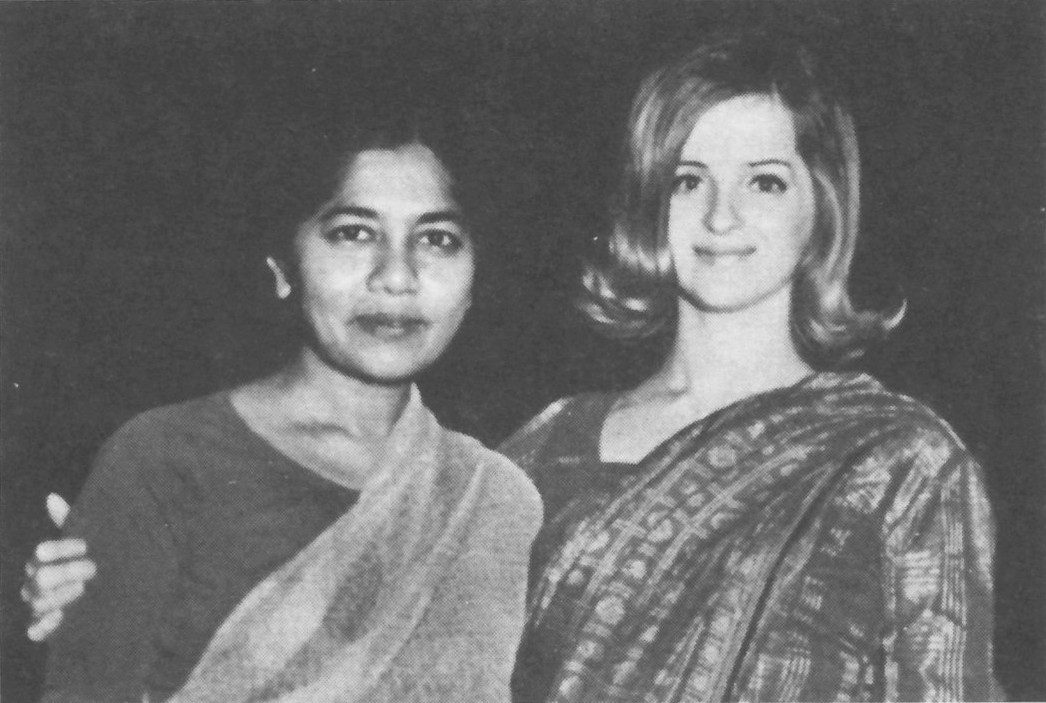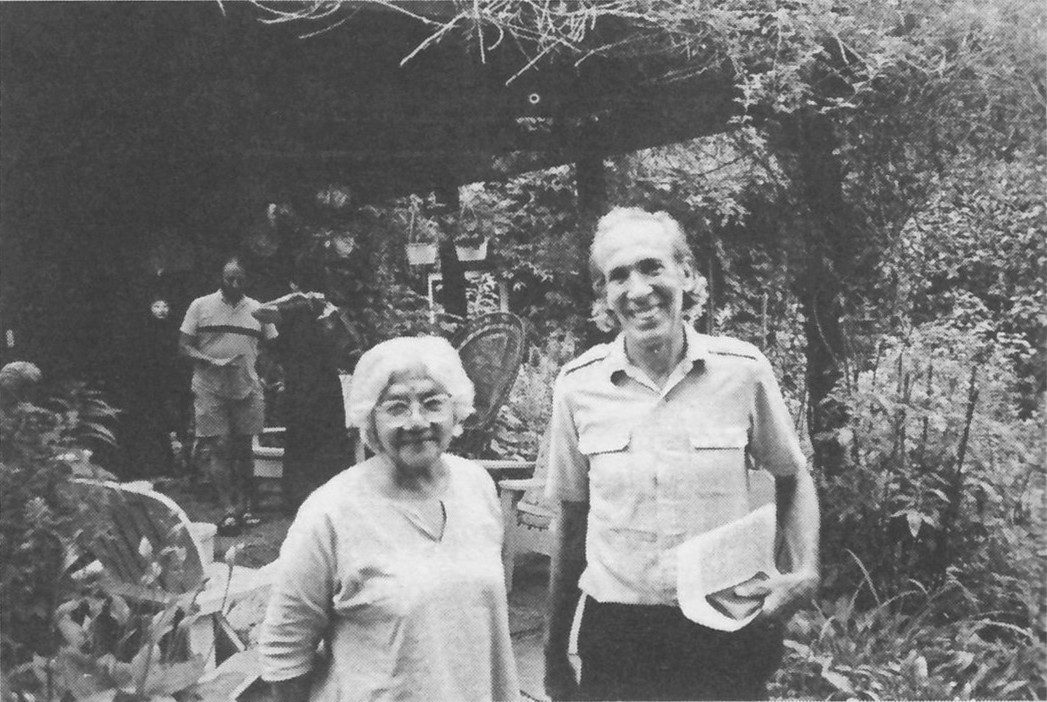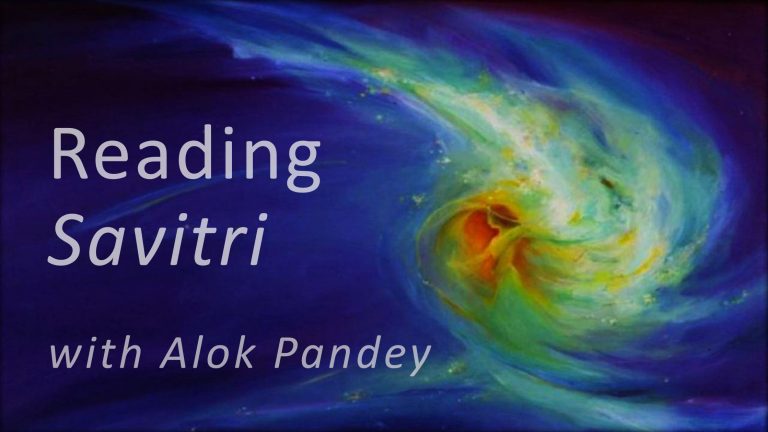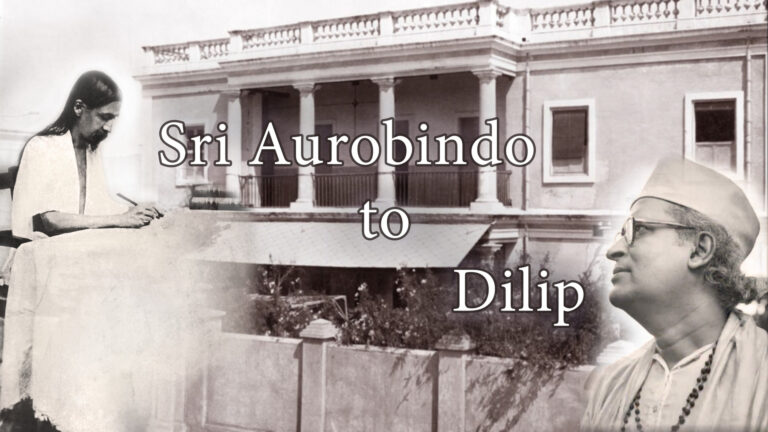Richard Pearson
(Teacher, Botanist, Captain and Editor of
‘Flowers and Their Messages’)
Richard Pearson was just eleven years old when he first came to the Sri Aurobindo Ashram with his English father in 1946, after the close of World War II. He was born in the north of England on November 1, 1934 in a town called Shepley in Yorkshire. The town was thus named for its reputation of being sheep country. As a child Richard was very close to nature and animals and used to play in the grassy fields where wild flowers bloomed and goats, sheep and other animals grazed. His grandparents were of Russian Jewish heritage and had left Russia for England. His father was born and educated in England.
Both parents were nurses. Neither parent was keen on religion but Richard joined the local church choir. He remembers the pastor saying that if they had any questions about God, they could write and ask him. Richard did so and was not satisfied with the answers. He thought he would write about God! Later, when he was in the Ashram, he showed his childhood writings to the Mother and she helped him with spellings and said, “As you grow older your ideas about God will also change.” Richard said he was a rather austere, shy young boy and somewhat fanatical about being morally correct.
When Richard was ten years old his father joined the Royal Army Medical Corps as a nurse, and he saw very little of him after that time until the war ended. Richard’s mother was left to care for the two children on her own. Reacting to some changes in his family life, Richard said he became a rather difficult child. During this period he was sent to live with other families and could not understand why he was always moving around constantly. He was unhappy without his mother and having to stay with so many strangers.
His father had been posted in India and wrote to Richard’s mother that he wanted to settle in India when the war was over. He asked if they would like to come and live there. Remembering the jungle and wild animal stories he had read about, Richard said,
“It’s a great idea!”
Ultimately his mother took him to stay in a boarding school in Somerset “far from anywhere”, he said. It was a boys’ school and the headmistress was a terror. They were all underfed and lived in very trying conditions. Richard became a kind of mentor and counselor to the other boys and answered their questions to their satisfaction. Although he was alone and without family he said he never really felt alone. He felt that “somebody” or “something” was always with him; a Presence that he could feel. He used to lie in the wheat fields alone in the evenings looking up at the sky. On one of these evenings he had a very profound and concrete experience of the infinity of the universe and of the limitlessness of the sky. The more he would gaze the more limitless was his vision.
How did you eventually come to the Ashram to live?
My father was a reader of philosophy. He collected books on spirituality and philosophy. He had plenty of free time in India and read Sri Ramakrishna and Sri Ramana Maharshi. Soon he discovered Sri Aurobindo’s The Life Divine. While in Calcutta, he went to the Sri Aurobindo Bhavan and met Rajen-da and Madan-da, who settled later in the Ashram. They encouraged him to seek permission to visit Sri Aurobindo Ashram. So on August 15, 1943 he had his first darshan of Sri Aurobindo and was completely taken in. I could not leave London until the war was over. By October of that year I left boarding school and stayed with my Mother’s family for a time. Afterwards, I went to London to live with Norman Dowsett’s family. [Norman Dowsett was a teacher in the Ashram school for many years.] My father had made an acquaintance with Norman Dowsett who was, at that time, in the Royal Air Force. I lived with them for four months and went to school in London. Later, I travelled with them to India by ship. We arrived in India on February 21, 1946. My father came to receive me at the port in Bombay. It was toward the end of the British rule and there was a “Quit India” movement at that time to get all the British out of India. We had to leave Bombay very quickly. We travelled two days together by train destined for Madras. We took another train for Pondicherry. On the train, my father took out his wallet and showed me photos of Mother and Sri Aurobindo and said, “We are going to see these two great people.” I felt mystified by it. We went straight to Leena Dowsett’s house. On arrival a message came to us, given to them by the Mother, that we were to see her after breakfast!
Could you describe that meeting with the Mother and your impressions?
We went with Udar, Norman and Leena and their children to Pavitra’s room. My father said, “Fold your hands and say, ‘Bonjour douce Mere’. If she touches you, you can touch her feet.” I was just this shy little boy from England. Suddenly a dog came charging into the room. This was the Mother’s dog named “Goldie”. I was so fond of animals but this took me completely by surprise. Then, the dog left the room just as quickly as it had entered. At that moment, the Mother came in. It felt as though a strong gust of wind had swept into the room because there was such vitality in her presence. She said “Good morning, everybody” and shook each one’s hand in a true English way. Everything happened so fast that I forgot all that I was supposed to say. She began to ask questions about our journey and if everything was all right.
Do you have any other impressions of the Mother?
One strong impression that I have of the Mother was that she was always dashing forward. One occasion that I remember when she showed this quality was in the playground during one of her Wednesday night talks. She had given a “bang” to our laziness as no one was asking questions. She was in a warrior mood. She marched out with such determination as if to show us how one is to move forward. The second instance was around 1956 during a rehearsal of the play “The Spiritual Destiny of India”, in the Ashram school. The Mother had taken a keen interest in the play and had given her directions for the smallest details. She was talking to the organizers and said, “And what shall we do next year?” That play had not yet taken place and the Mother was already planning ahead. This power of the Shakti was truly impressive to me.
When did you begin classes in the Ashram school? What was your life like in those early days?
I began school the very next day after meeting the Mother. I did not speak French so I had to learn. Later, it became such a fascination (because the Mother spoke to us in French) that I picked on anybody who could speak French well in order to better learn how to speak the language. Sunil-da became my teacher and later my mentor. He was very important to me and my intellectual growth and development. He taught me math, astronomy and botany. I left the Dowsetts’ home within a few days and went to stay with Udar’s family and took my meals with them. They taught me how to wear a dhoti. (My father had returned to Madras where he was still waiting for final clearance from the army.) There I met Ambu who became my model. I wanted to be strong like him and I learned asanas from him. He taught me how to wash my clothes, to dress like an Indian and to take care of things. I made friends with Gauri’s dog, “Spotted Beauty”, a Dalmatian. They also had a donkey named “Baudet”. Udar had purchased it for the Mother and kept it in his garden. I asked Mother if I could look after it and she gave permission. Gauri was my friend but I did not have the time or take the time to make other friendships. I spent a great deal of time on their terrace looking out on the sea and I began to write again. I began to see everything turning itself to the Divine; the waves, the clouds. Everything gave me the sense of self-giving and offering of itself to the Divine. I used to sit quietly and receive these impressions. Since I was so shy I preferred to stay by myself. [The following is an example of Richard’s childhood writings that was shown to the Mother]
By The Sea
“We often watch the sea rushing towards land with its high waves towering up. As they reach the shore, these waves come down from their heights and roll up the beach in a thin layer of white foam.
“The waves trying to reach the shore are like people trying to find the Divine.
“Some waves are big and have a lot of foam. They get bigger as they come nearer the shore. They are just like the rich people with a lot of money who are trying to get rid of their riches to reach the Divine, but He is putting them through a test—the more they give, the more they get.
“There are big waves and small waves, but it is all sea. And there are rich men and poor men, but they are all the Divine’s children seeking their Divine Mother.
“As they come nearer, the waves all come together, and joyfully they rush on to the beach. People coming near to the Divine collect together. They bend down and all becomes love for the Divine.”
Will you please share your experience of the first darshan with Sri Aurobindo?
In the early days there was no line except from the Meditation Hall. Everyone sat in the courtyard. We had a three-day holiday from school; the day before darshan, darshan day and the day after, which was called Garland Day. It felt as though one walked in some other world. We entered the darshan room and it felt like a cool, dense forest, intense and quiet. Although I was so short and there were tall people in front of me and I couldn’t see, I could feel a solid peace—something very solid… a force, a light, intangible but inexpressible. Even though they sat in the anteroom one had a sense of being in the same room with Mother and Sri Aurobindo. Sri Aurobindo for me, as a child, was like viewing a mountain. He was so majestic. When I was still quite young I used to wonder what he was doing in his room all day and why we only saw him four times a year. The Mother seemed like a Queen when she sat next to Sri Aurobindo. Sri Aurobindo was truly regal. His presence was felt even before standing in front of him. There was a great coolness in the room. The very first time I entered the Ashram I could feel this coolness and peace in the atmosphere. To this very day when I am in a state of deep quietude, I can still feel this atmosphere of Sri Aurobindo’s darshan very strongly. Sri Aurobindo looked austere and impassive. The Mother was radiant and smiling! There were some darshan days when the Mother would be in a trance. Sri Aurobindo would be smiling and gracious. One felt a warmth and sweetness from him.
Darshan days were quite different from other days when one met with the Mother. They were a much more powerful experience. Mother said darshan is the culmination or the fulfillment of a great deal of work that had been done. One had to prepare for the darshan within oneself to receive the blessing. Mother said, “Preparation in oneself is what makes darshan so special.”
What did you do after you finished your courses in the Ashram school?
I had asked Mother if I should take my higher courses in England. She wrote back:
“I intended to let you go for your studies in England without telling you anything about it, because each one must be free to follow the path he has chosen. But after what you have written I feel compelled to write to you.”
“No doubt from the exterior point of view, you will find in England all that you want for learning what human beings generally call knowledge, but from the point of view of Truth and Consciousness, you can find nowhere the atmosphere in which you are living here. Elsewhere you can meet with a religious or a philosophic spirit, but true spirituality, direct contact with the Divine, constant aspiration to realise Him in life, mind and action are in the world realised only by scattered individuals and not as a living fact behind any university teaching however advanced it may be.”
“Physically, as far as you are concerned, there will be a great risk of drifting away from the experience you have realized and then you cannot know what will happen to you. That is all I wanted to say — now it is left to you to choose and decide.”
Of course, I did not go. The Mother then said I could study botany in the Ashram library and I received special permission from Medhananda to do so. Mother asked me to take on teaching an English class in the school while I was studying. At the age of 18, I was only slightly older than the students that I was teaching. When the new lab opened. Mother told me to work there. This was my first training in physical work done for the Mother. I labelled bottles, packets, lab equipment and chemicals. Then a separate room was given for natural history items such as seeds, feathers and dried fruits of plants and trees, stones and even an elephant’s head! I was given permission to keep and attend to wounded animals; snakes, crows, squirrels, etc. When Mother received pressed flowers and other plants, etc., she would send them to me to keep carefully. Mother would write and give me guidelines about so many things. Particularly about teaching and outings. I used to take the children on nature outings and would go on nature outings with Sunil-da.
I hear that you received the “Prix d’Honneur” from the Mother. Can you tell us something about it?
Well, from 1954 the Mother had started to give a special award of recognition, called “Prix d’Honneur” to a student who showed exceptional qualities in all the activities and branches of education and whose conduct conformed to the ideal of the Ashram from all points of view. It was in 1955 that the Mother chose this honor for me.
Did you ever live with your father?
I lived with Udar’s family for a few months until my father arrived, after being released from the army. The Mother gave him a room and I stayed with him until 1956 at which time he left. He got several schools started on the lines of the Mother and Sri Aurobindo; one in Bhagalpur, one at the Delhi Ashram and one in Bangalore. It was in 1962 that he invited me to help him as a teacher in Bangalore.
Did you go?
I asked the Mother. She replied to me in strong and touching words. She said, “Richard, my dear child: I have absolutely no intention of letting you leave from here — we have need of you and your excellent work. I consider you like my son and I have great confidence in your future from the point of view of yoga. With my blessings.”
Tell me about your connection with physical education and how you became a captain?
In the very beginning I was not so interested in games and sports but I did love gymnastics and swimming. We also had more of boxing than I enjoyed, since Biren Chandra, our captain and leader, was a well-known boxer.
Later, when the Mother sat and watched the strong men, boys and a couple of girls doing strengthening exercises after group was over, I used to practise roller-balancing in a corner by myself. Even later, our captain gathered together a select group to study, reflect and discuss the means of applying Mother’s and Sri Aurobindo’s teachings in our life and activities both individually and collectively.
When my name was suggested for taking group as a captain the Mother refused to accept it. She told me that I should not have to run from one activity to another. “Work done well is work done quietly,” she added. When the Captains’ Group was formed in 1963, however, it was the Mother who then accepted my joining. I was chosen to address the prayer to her in the playground on the occasion of wearing our new uniform (24 April 1963).
How did you meet Kailas and in what way did the Mother encourage your relationship?
Our meeting came at a time when I had overworked myself. I had no servant and was teaching and doing the lab work. I wanted to take a beehive from a tree trunk and set about to do this on my own and I was stung. One sting became septic and a stinger remained in one little finger. I had to go to the nursing home and Dr. Sanyal operated to remove the stinger. After this he went to New York for his own operation for Parkinson’s Disease and Kailas met him while there. He told her when she was ready to come to the Ashram he would arrange for a place for her to stay. The nurse who looked after me was Janina, the artist. She brought me back to life as I was in a critical stage. I had no stamina and was very weak and thin. Mother gave Janina the Force for this work.
She showed me that the dark side of oneself is also one’s self and has to be accepted and offered to the Mother. Janina passed away on her birthday, July 17, 1964.
Kailas and Anie, Ashram Theatre, 1968
Kailas and Richard – Matagiri, New York, 1999
Kailas arrived August 14, 1964. She was brought to the nursing home as there was no vacancy anywhere in the Ashram. I was thirty years old at that time. Kailas taught me how to be open with myself. I did not have many friends and didn’t know how to make social contact. I went with Kailas to see the Mother on her birthday, June 11, 1965. Mother gave several large books to Kailas and turned to me and said, “Aren’t you a gentleman?” She meant that I should have thought of helping Kailas with the books, but I was so shy. I was a different person before Kailas arrived. I was always resisting everything and reluctant to show my feelings. I would not even stop to take tea. Mona Pinto used to say about me, “This boy never had a mother!”
Kailas would ask, “Is there anything you would like to discuss?” I wasn’t accustomed to that kind of interaction, but began to find the value of sharing my thoughts and feelings with others. During that period the Mother sent us a copy of Sri Aurobindo or the Adventure of Consciousness and asked us to read it together. This drew us closer together and we began to have fixed times for meditation and to share our meals. Kailas was so free, full of vitality and exuberance that I began to change from a shy person to a sociable, joyous one.
Kailas and I had two things in common: a love of beauty and a love of flowers. She knew their significances. She had started a sort of communion with the Mother through flowers which lasted for over four years. She started it by sending a dinner-size dish filled with “purity” (jasmine) with a lotus-shaped small vase in the center, holding a rose of “Surrender”, both of which indicated her aspiration. The Mother took them herself and filled her dish with flowers of “Divine Grace”. This went on for as long as the “Divine Grace” was blooming. I watched this with great interest. The Mother then changed the flowers to the “Supramental Psychological Perfection”, again as long as they were in season, with the “Supramental Consciousness” in the center. Then the dish would come back with flowers of “Perfect Radiating Purity”, “Purity in Action” and so on. The central flowers could change to the “Supramental Sun” or anything connected with the Supramental or Sachchidananda. The Mother would arrange these flowers herself. After some time, I too started, when given permission, to send flowers for the Mother. The last flowers the Mother sent to me were a garland of “Devotion”. I used to press all the flowers sent to us. We would send flowers covered with a beautiful cloth. In the Indian tradition, when flowers are given to the guru, they should not be seen, touched nor smelled by anyone else.
Mother said, “When I give them [flowers] I give you states of consciousness.” [Flowers and their Messages IX]
When did the flower work begin and the work on the book Flowers and Their Messages?
I was always touched by the array of flowers arranged in trays when we went one by one to see the Mother. Mother would give us a flower and look deeply into our eyes, so very deep. I would take the flower straight home and keep it in a bottle or vase and would keep it fresh for as long as possible. [“Answering with the flower’s answer to the sun, they gave themselves to her and asked no more.” Savitri, Book IV, Canto 2.]
From the beginning when I saw the book by Lizelle Raymond, a French woman living in the Ashram, who wrote Le Role de Fleurs, published in 1953, I found the introduction to be a masterpiece. It was about how flowers were offered to the Mother and how the Mother gave her blessings through flowers. “There are three ways of blessing of the Mother: by sight, by touch and through flowers. And it is through flowers that her blessing is most effective.” Sri Aurobindo is reported to have written. I was very touched by the book. All the flowers were in order according to the French names given. When I saw it I found some mistakes in the botanical names and in the significances. I wrote to the Mother asking if I could work on a flower book that would contain all the names Mother had given. Mother said “Yes, this could be done.” This development began the new classification in 1957, but was not completed until 1973. During this work, Pavitra sent messages to the Mother for me. He was another of my mentors. When I went to his room, as soon as I entered, I would feel that I was in the Mother’s room, so strong was her Force. In his presence I would feel the presence of the Mother. [Pavitra, a Frenchman, whose European name was P.B. Saint-Hilaire, was a highly skilled scientist and engineer. He was head of the Ashram school and secretary to the Mother. Pavitra’s name, given by Sri Aurobindo, means “the pure”.]
When Auroville was inaugurated and the idea for the twelve gardens was being worked out with Roger, Mother called me to bring as many hibiscus flowers as possible to Auroville. I went every Tuesday. At the first meeting with Mother she explained that she wanted to choose a hibiscus flower for each of the twelve gardens. The first day she chose “Supramental Consciousness” for the Garden of Consciousness. “It is so luminous,” she remarked. Richard Eggenberger (named Narad by the Mother) helped me in bringing the flowers. The work on the flowers began with great vigor in the first gardens of Auroville when Narad started the nursery for Matrimandir Gardens in 1969. He collected many varieties and beautifully built up the gardens.
Hibiscus flowers would come from the nursery for the Mother and would be left at the Ashram reception. Kailas and I would go and, if possible, paint these flowers before they went upstairs. Mother first called “Godhead” the Auroville flower, but then changed it to “Beauty of Supramental Love”. She told me that this flower was similar to the rich, red color of Auroville soil. Many hibiscus were given names for Auroville: “The Success of Auroville”, “The Firmness of Auroville”, “The Concentration of Auroville”, etc. Later, she changed the word Auroville to “New Creation”.
The biggest gift from the Mother for the work with flowers were the commentaries she gave on the flowers. The Mother would work on about five flowers a day at a fixed time. This was checked the following day by Tara. These commentaries done in 1970 and 1971 were for the “flower book” which was still in progress. When they were translated by Tehmi into English, Narad came in the evenings, all the way from Auroville, to help with the botanical and common names and descriptions of the flowers and the plants for Flowers and Their Messages. Since Mother used flowers as a help for our spiritual progress, Kailas felt that relevant quotations from the writings of the Mother and Sri Aurobindo would help the reader, so she chose appropriate passages. Lyn Miller did the line drawings. At later stages I would go to the press to check certain details in the hand-set final proofs. The book was one of the early publications from Auropress.
Can you further share any stories about the Mother, more on your work for her or special anecdotes that you remember?
The Mother was so fond of flowers, according to Jyotin-da, that in the early days, before the Ashram had gardens, to him the old saying “beg, borrow or steal” was the method used to procure flowers for the Mother for distribution. So, with hurricane lantern, stick and basket in hand and a pair of nimble legs to climb over walls, our would-be gardeners went out by night or very early morning. Perhaps in those days of rigorous sadhana, when you would not go for a walk or to visit another sadhak without the Mother’s express permission, the end justified the means! But when during one such “sortie” a sadhak, who was not quick enough to jump the fence, was caught and even put behind bars for the offence, the Mother decided it was time to develop gardens and gardening. One of the first gardens, Maret Garden, was called “Atal’s Garden” by the sadhaks, for Atal, the very same person who went to jail, was put in charge!
Those were the days when houses or gardens could be haunted by spirits up to some mischief, so dear Atal-da had to deal, himself, with not-so-pleasant intruders!
After a few years the townspeople too, really came to know of the Mother’s magical ways of forcing “Matter to express the Spirit”.
Once the Mother had decided that flowers would be grown in our gardens, she encouraged gardeners to try out all sorts of new varieties of flowers and vegetables. When a flower and vegetable show was arranged at the local botanical garden in Pondicherry, the flowers and plants displayed by the Ashram created an overwhelming presence of beauty and joy and peace: the beauty and bliss of the Divine Mother’s Grace! [“Flowers bring with them the smile of the Divine” — from Prayers and Meditations.]
Many were the stories Jyotin-da, another sadhak, would tell. This is one that had baffled him when he tried to fathom the Mother’s ways with her children. He told me of a flower I had not seen though I knew the tree. It was “Jerusalem Thorn” (Parkinsonia aculeata). He had taken it several times to the Mother when he saw it bloom, but she had not given it any significance. Others had tried asking her but in vain. It was during the very early days of Auroville and there was a young girl in her teens who had come to the Mother on her birthday. She brought these flowers with their feathery leaves to Mother. Mother smiled as she took the flowers and exclaimed, “Oh, this is Lightness!” The girl, with lovely blonde hair flowing over her shoulders, was studying to be a ballet dancer! Pavitra once asked me, when I was enthusiastically trying to persuade him to ask the Mother about a particular significance: “Do you think the Mother gives the name for the flowers, or for us?” At that moment I truly believed she gave names only to the flowers, but after this and other such experiences, I am convinced that it is both terrestrial and an individual gift of the Divine Mother.
With the children who arrived with their parents after 1939, little by little a new energy was present in the Ashram and one of the first things the Mother did was to use the French name for the flowers when talking with the children. By 1943, when the school officially opened, French became the language of instruction, as Mother would speak in French. The greetings of “Bonjour!” and “Bonne Fete!” have defied time and space and even now form that beautiful bond that unites us all with her. Also, the Mother encouraged all forms of art and handiwork — embroidery, painting, carpentry, leather work — all means of expressing beauty by consecrated service and work, obliging matter to obey the spirit! The Ashram artists were only a handful in those days; Anilbaran, Jayantilal, Krishnalal, Sanjiban, etc. They painted as their offering to her. Though interested in land or seascapes, they also painted flowers for the Mother to name and she kept these paintings in Pavitra’s room until they were later moved to The Studio.
How did you feel when you went to the Mother on your birthday?
The following quotation from Prayers and Meditations would best describe what we felt when the Mother gave flowers for our birthday, the most special day, individually speaking, of the year. We saw her several times on that day and each time we would receive a special bouquet or garland and her special flower, her smile and her presence.
“Each time that a heart leaps at the touch of Thy divine breath, a little more beauty seems to be born upon the Earth, the air is embalmed with a sweet perfume, all becomes more friendly….
“At these blessed hours all earth sings a hymn of gladness, the grasses shudder with pleasure, the air is vibrant with light, the trees lift towards heaven their most ardent prayer, the chant of the birds becomes a canticle, the waves of the sea billow with love, the smile of the children tells of the infinite and the souls of men appear in their eyes.” [Prayers and Meditations, March 31, 1917.]
* * *
Richard and Kailas continue to offer their lives in service to the Mother. They are well known and loved in the United States and have visited many centers giving talks and beautiful slide presentations on Flowers and Their Messages. They live in the Ashram but visit Auroville frequently. They receive and assist visitors and newcomers and both have given talks at the Savitri Bhavan in Auroville, participating in the series of intimate sharings entitled: “Remembering the Mother”.






